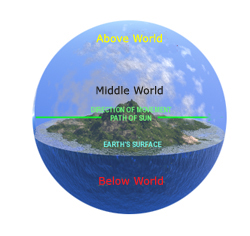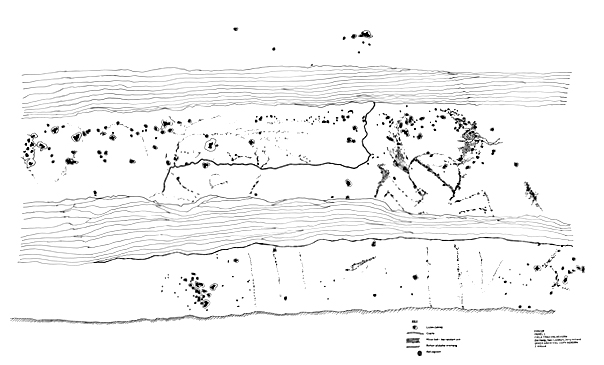Portals Between the Worlds / Underwater Spirit
By Deborah Sabo
In traditional Southeastern Indian beliefs, the cosmos is considered as three layers: Above World, Below World, and Middle World. Above World is the sky, associated with creative forces, the abode of perfect spirit beings and the souls of ancestors. Below World is watery and unformed, associated with destructive forces, inhabited by imperfect spirit beings and monsters. Middle World is the earth’s surface, floating above the watery Below World, inhabited by human, plant, and animal communities. In Indian mythology, stories tell of spirit beings or heroes crossing the borders of these realms for various reasons: spirits to create something if they are benevolent, or to cause destruction if they are not; heroes to avenge some wrong or to gain some benefit for their people. In these stories, the ability to move between the Worlds is a sign of power. Sometimes this is shown by special magical possessions of a hero character. Sometimes a powerful spirit being has combination features of animals belonging to more than one World. And sometimes the story uses location to indicate this crossing. For instance, in an Osage creation story, the First Ancestors descend from the sky, floating down with their arms held out almost like glider wings. They alight in the branches of tall trees. In a Caddo story, the ancestors climb up from Below World and emerge on the earth’s surface through the mouth of a cave. In both examples, extremities in Middle World act as portals or doorways. In the first case, it is heights: the upper limbs of tall trees. In the second case, caves: earth openings that lead underground. Very often in mythology a sacred place is a mountaintop or a cave or a well or spring or other water feature. These are all crossing places between domains. A high mountain links the earth with the sky. A cave links the earth with the underground. A well or spring or lake is a place where water from below bubbles to the surface. One fascinating example of rock art in northwest Arkansas indicates an interest in the theme of “portals between the worlds.” This pictograph panel shows a horned figure with a round head and down-turned arms. The horns are filled in with red paint, but the rest is shown just in outline. The round head—looking straight forward—has no facial features to distinguish it, but is decorated with a single diagonal line, like face paint. The figure is drawn above a horizontal fissure in the rock wall, and looks as if it is “emerging” through this fissure from underground. The arms are shown with the elbows slightly raised and then the forearms bent down. This gives an energetic appearance as if the figure is lifting itself over the edge of the rock. Below the fissure, are two parallel vertical lines suggesting the figure’s lower body.
Next to this is another, much more faded figure. Again there is a round head drawn just above the fissure in the rock face. This time the image has facial features, though without much detail. There are triangular shaped eyes with linear extensions (this resembles a motif called “hawk’s eye” in Southeastern Indian art) and a lunate, down-turned open mouth. Extending from the head are two thin branching structures like antlers. As with the first horned figure, there are vertical parallel lines suggesting a simple body structure below the fissure. If we think of these figures as human beings wearing horned headdresses, we might see these lower parallel lines as stick-figure legs. The horned headdress would be an emblem of a shaman or medicine man. The shaman, in Indian culture, was a person with the skill to travel in spirit form between the Worlds. He (or she) often dressed in special clothing or carried special equipment to mark his profession—in this case, the horned headdress. In the first figure, the horns look very much like buffalo horns. This representation would be unique for Arkansas rock art and shows an affinity with Plains rock art rather than Eastern Woodlands examples. A possible interpretation, then, is that the panel shows shamans wearing horned headdresses, traveling in spirit form through a portal between This World and Below World. Perhaps they are returning from their spirit journey, and their bodies, shown so indistinctly by the parallel lines, are still in the “other world.” There is another possible interpretation of these two pictograph images. Underwater Spirits are powerful beings said to inhabit the watery Below World. These creatures are described in stories and depicted in art with either serpent- or cat-like bodies, a head with horns or antlers, often a long coiled tail, and sometimes wings. Not every representation necessarily combines all these features. Our pictographs bear a resemblance to an Underwater Spirit pictograph from Picture Cave in Missouri (Diaz-Granados and Duncan 2000:70). This image has a round head with antlers, facial features including an open mouth with teeth, and an amorphous, undulating body. In stories told by Southeastern Indians, the Underwater Spirit sometimes came up from lakes or other water bodies and attacked the people they found. (To read a Cherokee story about the Underwater Spirit click here.) In light of this, it is worth noting that the site where our horned pictographs are located is very close to water—the White River (now Beaver Lake) flows right past the bluff, and the bottom of the pictograph “bodies” is close to the water’s surface. Whether our figures represent shamans wearing horned headdresses, or spirit beings from the watery underground, they are distinctive examples of rock art depicting the theme of travel through a portal between the Worlds. Reference Cited Diaz-Granados, Carol, and James R. Duncan 2000 The Petroglyphs and Pictographs of Missouri. The University of Alabama Press, Tuscaloosa. |
| Home | Quick Facts | Interpretations | Articles | Technical Papers | Resources | Database | Just For Kids | Picture Gallery | Buy the Book! |
|
Last Updated: July 20, 2012 at 2:22:26 PM Central Time
|



